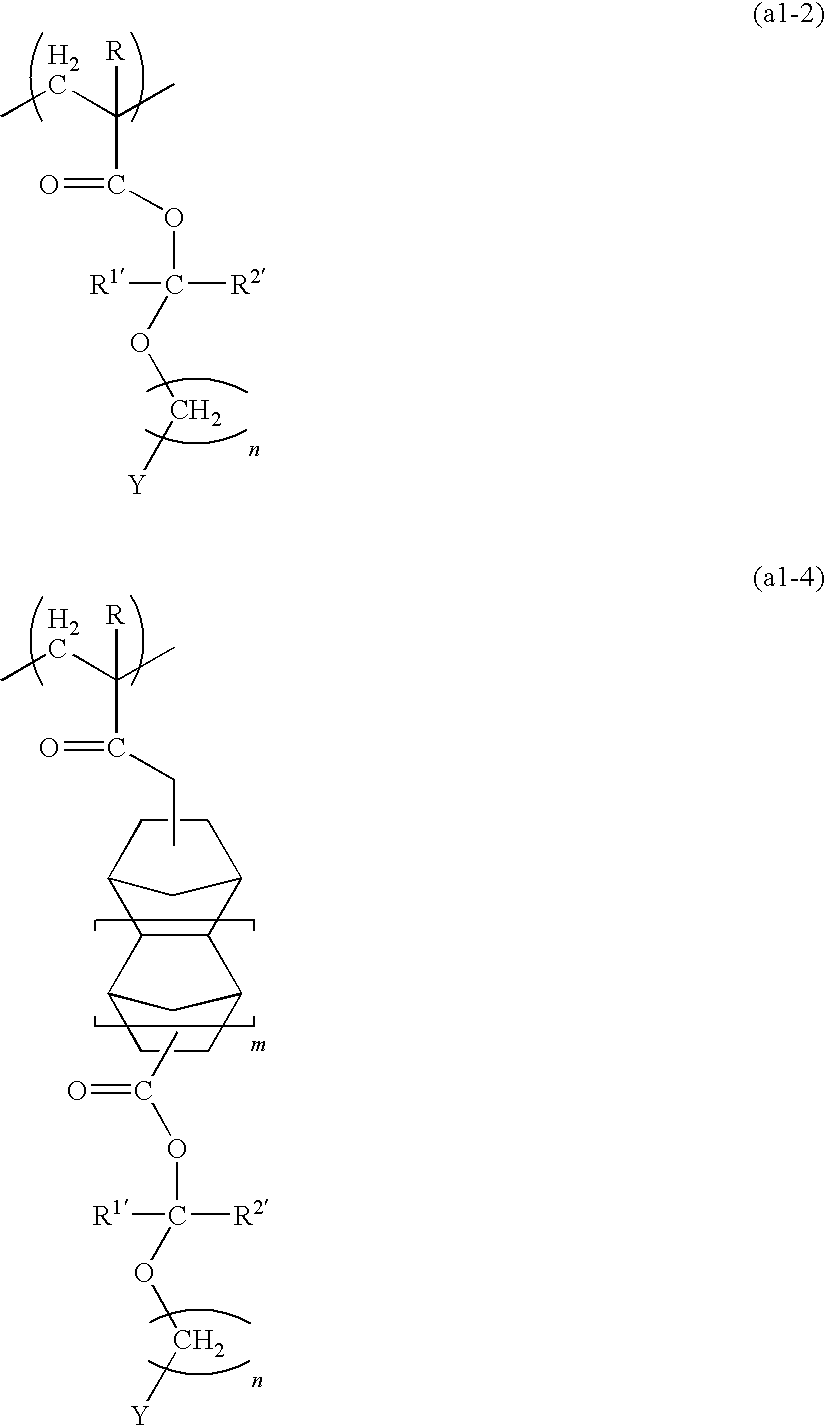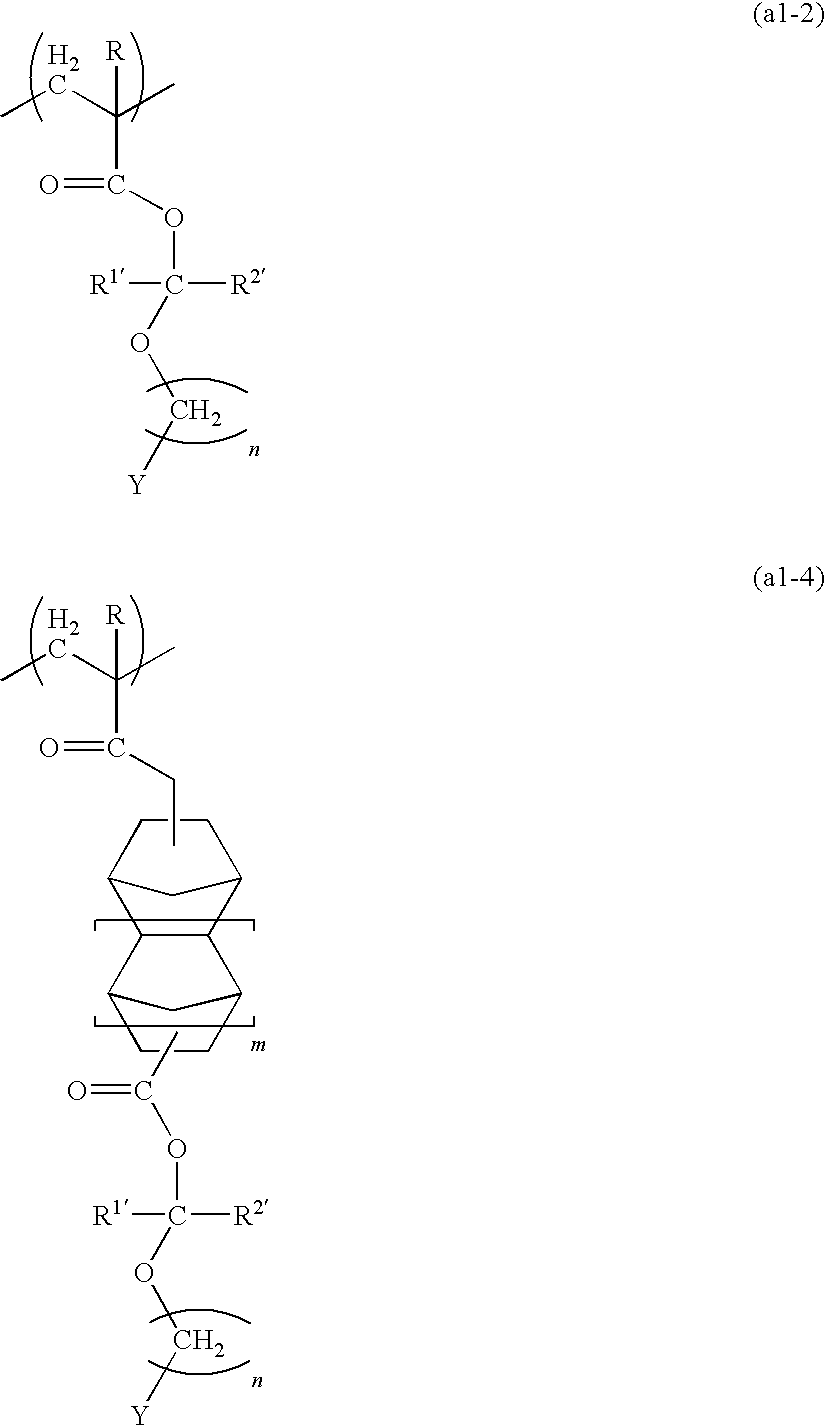Positive resist composition and method of forming resist pattern
- Summary
- Abstract
- Description
- Claims
- Application Information
AI Technical Summary
Benefits of technology
Problems solved by technology
Method used
Image
Examples
synthesis example 1
Synthesis of (2-adamantyloxymethyl)methacrylate
[0200]6.9 g of methacrylic acid was dissolved in 200 ml of tetrahydrofuran, and 8.0 g of triethylamine was added. Following stirring at room temperature, a solution containing 15 g of 2-adamantyl chloromethyl ether dissolved in 100 ml of tetrahydrofuran was added dropwise to the reaction solution. Following stirring for 12 hours at room temperature, the precipitated salt was removed by filtration. The solvent was removed from the remaining filtrate by evaporation, the residue was dissolved in 200 ml of ethyl acetate, and following washing with pure water (100 ml×3), the solvent was removed by evaporation. The residue was then allowed to stand under ice cooling, thereby yielding a white solid.
[0201]Results of measuring the infrared absorption spectrum (IR) and the proton nuclear magnetic resonance spectrum (1H-NMR) are shown below.
[0202]IR (cm−1): 2907, 2854 (C—H stretch), 1725 (C=O stretch), 1638 (C=C stretch)
[0203]1H-NMR (CDCl3, intern...
synthesis example 2
Synthesis of Resin 1
[0205]20.0 g of the (2-adamantyloxymethyl)methacrylate obtained in the above synthesis example 1, 13.6 g of γ-butyrolactone methacrylate, and 8.8 g of tricyclodecanyl methacrylate were dissolved in 200 ml of tetrahydrofuran, and 1.64 g of azobisisobutyronitrile was added. Following refluxing for 12 hours, the reaction solution was added dropwise to 2 L of n-heptane. The precipitated resin was collected by filtration and dried under reduced pressure, yielding a white resin powder (resin 1).
[0206]The structure of the resin 1 is shown below.
[0207]The results of a GPC measurement of the resin 1 revealed a weight average molecular weight (Mw) of 7,000 and a polydispersity (Mw / Mn) of 2.6. Furthermore, analysis by carbon-13 nuclear magnetic resonance spectroscopy (13C-NMR) revealed a compositional ratio between the different structural units shown in the structural formula below of p / q / r=40 / 40 / 20 (molar ratio).
synthesis example 3
Synthesis of Resin 2
[0208]20.0 g of the (2-adamantyloxymethyl)methacrylate obtained in the above synthesis example 1, 18.9 g of norbornane lactone methacrylate, and 8.8 g of tricyclodecanyl methacrylate were dissolved in 200 ml of tetrahydrofuran, and 1.64 g of azobisisobutyronitrile was added. Following refluxing for 12 hours, the reaction solution was added dropwise to 2 L of n-heptane. The precipitated resin was collected by filtration and dried under reduced pressure, yielding a white resin powder (resin 2). The structure of the resin 2 is shown below.
[0209]The results of a GPC measurement of the resin 2 revealed a weight average molecular weight (Mw) of 7,700 and a polydispersity (Mw / Mn) of 1.8. Furthermore, analysis by carbon-13 nuclear magnetic resonance spectroscopy (13C-NMR) revealed a compositional ratio between the different structural units shown in the structural formula below of p / q / r 40 / 40 / 20 (molar ratio).
PUM
| Property | Measurement | Unit |
|---|---|---|
| Temperature | aaaaa | aaaaa |
| Temperature | aaaaa | aaaaa |
| Temperature | aaaaa | aaaaa |
Abstract
Description
Claims
Application Information
 Login to View More
Login to View More - R&D
- Intellectual Property
- Life Sciences
- Materials
- Tech Scout
- Unparalleled Data Quality
- Higher Quality Content
- 60% Fewer Hallucinations
Browse by: Latest US Patents, China's latest patents, Technical Efficacy Thesaurus, Application Domain, Technology Topic, Popular Technical Reports.
© 2025 PatSnap. All rights reserved.Legal|Privacy policy|Modern Slavery Act Transparency Statement|Sitemap|About US| Contact US: help@patsnap.com



